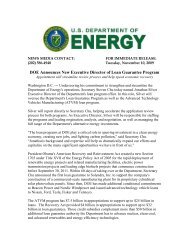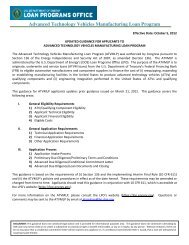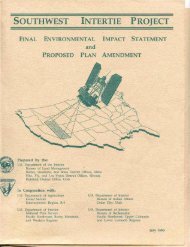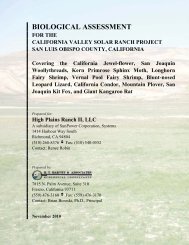Bureau of Land Management's Decision Record and Environmental
Bureau of Land Management's Decision Record and Environmental
Bureau of Land Management's Decision Record and Environmental
You also want an ePaper? Increase the reach of your titles
YUMPU automatically turns print PDFs into web optimized ePapers that Google loves.
Jersey Valley Geothermal Development Project<br />
<strong>Environmental</strong> Assessment: NV063 -EAO8 -091<br />
A hazardous material h<strong>and</strong>ling, storage <strong>and</strong> transportation plan has been produced <strong>and</strong> would<br />
reduce the potential for fires (see Section 3.11). Ormat has also proposed environmental<br />
protection measures to further reduce the potential for human caused fires (see Section 2.1.11).<br />
Power transmission lines have been known to start fires either from arcing or electrocution <strong>of</strong><br />
birds. Installation <strong>of</strong> anti electrocution perching sites on power poles <strong>and</strong> maintenance <strong>of</strong> roads<br />
<strong>and</strong>/or constructing fuel breaks along the Rights <strong>of</strong> Way would also reduce potential impacts.<br />
3.8.2.2 Alternative 1<br />
The construction, operation <strong>and</strong> maintenance <strong>of</strong> Alternative 1 would differ from the Proposed<br />
Action only by the small increase (0.25 acre) in the total permanent surface disturbance. The<br />
impacts <strong>of</strong> Alternative 1 to vegetation would not be different from that <strong>of</strong> the Proposed Action.<br />
The mitigation measures recommended for the Proposed Action would be equally applicable to<br />
Alternative 1.<br />
3.9 WATER QUALITY AND QUANTITY<br />
3.9.1 Affected Environment<br />
The Nevada State Engineer <strong>of</strong> the Division <strong>of</strong> Water Resources, Department <strong>of</strong> Conservation <strong>and</strong><br />
Natural Resources (NDCNR-DWR) places the Jersey Valley Unit Area within the 142 square<br />
mile Jersey Valley Hydrographic Area (Number 132 <strong>of</strong> 232 in the State <strong>of</strong> Nevada)<br />
(NDCNR-DWR 2009a). The Jersey Valley Hydrographic Area is located within the Central<br />
Hydrographic Region (Number 10 <strong>of</strong> 14 in the State <strong>of</strong> Nevada), which covers nearly 30 million<br />
acres. The Jersey Valley Hydrographic Area makes up approximately 0.3 percent (about<br />
91,000 acres) <strong>of</strong> the Central Hydrographic Region.<br />
The Jersey Valley Hydrographic Area is one <strong>of</strong> seven ground water basins that are connected<br />
with the Dixie Valley ground water basin (Hydrographic Area Number 128), which together<br />
form a closed hydrologic unit referred to as the Dixie-Fairview Valley Area (Cohen <strong>and</strong> Everett<br />
1963). All seven <strong>of</strong> these ground water basins were “designated” by the State Engineer in 1978<br />
in order to better manage the ground water in Dixie Valley (NDCNR-DWR 2005;<br />
NDCNR-DWR 1978). “Designating” a basin gives the Nevada State Engineer additional<br />
authority in the administration <strong>of</strong> the water resources within that basin. Basins are typically<br />
“designated” by the State Engineer when permitted ground water rights approach or exceed the<br />
estimated average recharge. The Dixie Valley ground water basin has committed ground water<br />
rights <strong>of</strong> approximately 30,700 acre-feet per year (AFY), <strong>and</strong> an estimated perennial yield (the<br />
amount <strong>of</strong> water that can be drawn indefinitely without depleting the resource) <strong>of</strong> 15,000 AFY<br />
(NDCNR-DWR 201 Oh).<br />
The Jersey Valley Hydrographic Area ground water basin is recharged by precipitation,<br />
primarily spring snowmelt resulting in seasonal stream flows. Near-surface ground water is<br />
primarily stored in unconsolidated sedimentary deposits that range from a few hundred feet thick<br />
in Jersey Valley to over 1,000 feet thick in Dixie Valley (Cohen <strong>and</strong> Everett 1963). Ground<br />
- 64 -







